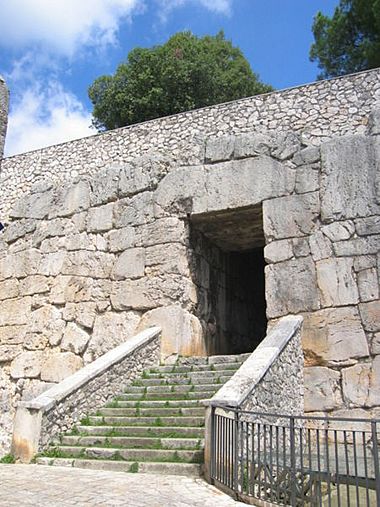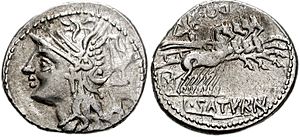Saturn (mythology) facts for kids
Quick facts for kids Saturn |
|
|---|---|
| God of the Capitol, time, wealth, agriculture, and liberation | |

Saturn wearing his toga “capite velato” and holding a sickle (fresco from the House of the Dioscuri at Pompeii, Naples Archaeological Museum)
|
|
| Major cult center | Temple of Saturn |
| Abode | Capitoline Hill |
| Planet | Saturn |
| Symbol | Sickle, scythe, veil |
| Day | Saturday |
| Gender | male |
| Festivals | Saturnalia |
| Personal information | |
| Consort | Ops |
| Children | Jupiter, Neptune, Pluto, Juno, Ceres and Vesta |
| Parents | Caelus and Terra |
| Siblings | Janus, Ops |
| Greek equivalent | Cronus |
| Norse equivalent | Odin |
| Etruscan equivalent | Satre |
Saturn (Latin: Sāturnus) was an important god in ancient Roman religion and Roman mythology. He was known as the god of time, wealth, farming, and freedom. People believed his rule was a "Golden Age" of peace and plenty. Later, the Romans connected him with the Greek god Cronus. Saturn's wife was his sister Ops, and they had many children, including Jupiter, Neptune, Pluto, Juno, Ceres, and Vesta.
Romans celebrated him with a big festival called Saturnalia every December. This was one of the most famous Roman festivals, a time for parties, gift-giving, and fun. The Temple of Saturn in the Roman Forum held the state's money and important records. The planet Saturn and the day of the week Saturday are both named after him.
Contents
Saturn's Story and Myths
The Romans linked Saturn with the Greek god Cronus. They used many of Cronus's stories for Saturn in their own literature and art. For example, Jupiter was known as Saturn's son, just as Zeus was Cronus's son in Greek myths.
Saturn had two main partners who showed different sides of him. His wife, Ops, was the Roman version of the Greek goddess Rhea. Her name means "wealth" or "plenty." Saturn was also connected to Lua, a goddess of "destruction" or "loosening." She received the weapons of defeated enemies.
During Saturn's time, people believed the Earth gave food freely without anyone needing to work. This was called the "Golden Age" by writers like Hesiod and Ovid. Saturn also became known as the god of time.
What Saturn's Name Means
The Roman writer Varro said Saturn's name came from satus, meaning "sowing." Another name for him, Sterculius, referred to his farming duties. This name comes from stercus, meaning "dung" or "manure." This shows his connection to things growing again after death.
Farming was very important to the Romans. Saturn was a key part of their old religion and identity. His name is even in an ancient song sung by the Salian priests. His temple was one of the oldest known in Roman records.
Some also believed the name Saturn came from the Latin word satis, meaning "enough" or "full." They saw Saturn as a human-like symbol of Time, which is filled by all things and all generations.
The Temple of Saturn
The Temple of Saturn was at the bottom of the Capitoline Hill in Rome. You can still see some columns from the last time it was rebuilt. This temple was very important because it held the state's money, called the aerarium, throughout Roman history.
Saturnalia: A Special Festival
Saturn is famous for a major Roman festival called Saturnalia. This festival was linked to ideas of time and the start of the New Year. In Greek stories, Cronus was sometimes connected to Chronus, meaning "Time." The myth that Cronus ate his children was seen as a symbol of how old generations pass away as new ones are born.
Cronus-Saturn's symbol was a sickle or scythe, like the one Father Time carries. This showed his link to farming. His old appearance also represented the end of the old year and the start of the new. Later on, Saturn was sometimes shown with wings.
Saturnalia celebrated the harvest and planting season. It lasted from December 17th to 23rd. During this time, the usual rules of Roman society were relaxed. The statue of Saturn, which usually had its legs tied with wool all year, was untied for the festival. The Greek festival similar to Saturnalia was called the Kronia.
A writer named Macrobius (from the 5th century CE) explained Saturnalia as a festival of light. It led up to the winter solstice, the shortest day of the year. The return of light and the new year were also celebrated later in the Roman Empire on December 25th, called the Dies Natalis of Sol Invictus (the "Birthday of the Unconquerable Sun").
Saturn's Roman Legend
Saturn was sometimes thought to be the very first king of Latium, which is a region in Italy, or even all of Italy. There was a story that Saturn came to Italy as an immigrant god. He was welcomed by Janus after his son Jupiter took over his rule and forced him out of Greece.
He arrived in Italy "dethroned and fugitive," but he brought farming and civilization with him. Because of this, Janus rewarded him with a share of his kingdom, and Saturn became a king himself. He was seen as the ancestor of the Latin people because he was the father of Picus, the first king of Latium. Picus married Janus's daughter Canens and later had a son named Faunus.
Saturn was also said to have founded five towns in Latium: Aletrium (now Alatri), Anagnia (Anagni), Arpinum (Arpino), Atina, and Ferentinum (Ferentino). All these towns are in the Latin Valley and have very old, large stone walls called cyclopean walls. People traditionally believed these walls were built by the Pelasgians.
Games and Shows
In later Roman times (around the 3rd century AD), records show that Saturn received special public games or shows called munera during or near the Saturnalia festival. These shows, which included gladiator contests, happened for ten days in December. They were paid for using money from Saturn's treasury.
Saturn on Coins
In 104 BCE, a Roman leader named Lucius Appuleius Saturninus made a silver coin called a denarius. On one side, it showed Saturn driving a four-horse chariot (a quadriga). This type of chariot was used by rulers, generals celebrating victories, and sun gods. The other side of the coin showed the head of the goddess Roma. This image of Saturn was a clever way for Saturninus to use his own name and show his plan to change the social system. He wanted to get support from the common people (the plebs) instead of the powerful senators.
See also
 In Spanish: Saturno (mitología) para niños
In Spanish: Saturno (mitología) para niños
- Saturn (mythology) § Notes
- Satre (Etruscan god)
- Saturnalia



